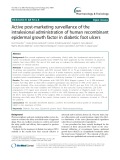
Highly toxic herbicide
-
This microbial consortium degraded 2,537.34 ngTEQ/kg of 2,3,7,8-TCDD congener in soil, equivalent to 59.1% lost of total toxicity in comparison to the control without bacterial seeding (4,294.12 ng TEQ/kg). Such a high ratio of dioxin degradation by a bacterial consortium was reported here for the first time, contributing more evidences for convincing the successful dioxin bioremediation of “Active Landfill” technology at large scale in Z1 area at Bienhoa airbase, Dongnai, Vietnam.
 8p
8p  nguyenxuankha_bevandan
nguyenxuankha_bevandan
 14-08-2020
14-08-2020
 10
10
 1
1
 Download
Download
-
Paraquat is a highly toxic herbicide, which not only leads to acute organ damage, but also to pulmonary fibrosis. There are only anecdotal reports of rescue lung transplantation, as paraquat is stored and only slowly released from different tissues.
 6p
6p  vienzym2711
vienzym2711
 03-04-2020
03-04-2020
 11
11
 1
1
 Download
Download
-
PART 3 Further issues and future prospects © 2001 C. H. Walker CHAPTER 13 The ecotoxicological effects of herbicides 13.1 Introduction Chapters 5–12 deal with groups of pollutants that have been studied in some depth and detail, largely because they have appreciable – sometimes very high – mammalian toxicity and are perceived as human health hazards. Some of them are markedly persistent and undergo biomagnification with passage along food chains.
 9p
9p  bengoan741
bengoan741
 24-12-2011
24-12-2011
 65
65
 7
7
 Download
Download
-
Introduction: As one of azide salts, lead azide is well known, because it is used as a detonator for air bags of automobiles. Recently, sodium azide has been frequently used for suicides and homicidal attempts. In this chapter, therefore, analytical methods are described only for sodium azide. Sodium azidea is being well used as an antiseptic (preservative)b in biochemical researches and as a material for synthesis of organic compounds.
 8p
8p  bigbaby87
bigbaby87
 01-09-2010
01-09-2010
 120
120
 8
8
 Download
Download
-
Introduction: Among many carbamate pesticides commercially available in Japan, those with relatively high toxicities are shown in Table 4.1 [1]. Carbamate pesticides are generally classified into N-methylcarbamate insecticides and N-allylcarbamate herbicides in view of their chemical structures and biological actions. The number of fatalities due to poisoning by carbamate pesticides is 50–100 every year in Japan; many of them are poisoned by methomyl [2].
 12p
12p  bigbaby87
bigbaby87
 01-09-2010
01-09-2010
 111
111
 14
14
 Download
Download
CHỦ ĐỀ BẠN MUỐN TÌM

















